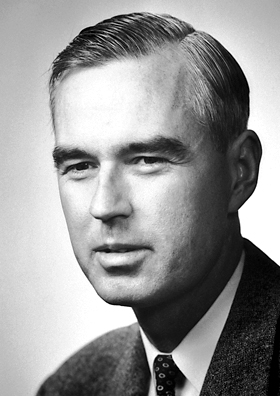Willis Lamb facts for kids
Quick facts for kids
Willis Lamb
|
|
|---|---|

Lamb in 1955
|
|
| Born |
Willis Eugene Lamb Jr.
July 12, 1913 Los Angeles, California, U.S.
|
| Died | May 15, 2008 (aged 94) |
| Nationality | United States |
| Alma mater | University of California, Berkeley |
| Known for | Lamb shift Lamb–Mössbauer factor Laser Theory Quantum Optics |
| Awards | Nobel Prize in Physics (1955) |
| Scientific career | |
| Fields | Physics |
| Institutions | University of Arizona University of Oxford Yale Columbia Stanford |
| Thesis | I. On the Capture of Slow Neutrons in Hydrogenuous Substances, II. Electromagnetic Properties of Nuclear Systems (1938) |
| Doctoral advisor | J. Robert Oppenheimer |
| Doctoral students | Bernard Feld (1945) Robert Retherford (1947) Norman Kroll (1948) Theodore Maiman (1955) Marlan Scully (1966) Balázs László Győrffy (1966) |
Willis Eugene Lamb Jr. (born July 12, 1913 – died May 15, 2008) was an American physicist. He won the Nobel Prize in Physics in 1955. He received the award for his important discoveries about the tiny details of the hydrogen atom's light patterns.
That year, the Nobel Committee shared the prize. Half went to Lamb and the other half to Polykarp Kusch. Kusch won for precisely measuring the magnetic strength of an electron. Lamb's work helped scientists understand a surprising change in how electrons behave inside a hydrogen atom. This change is now called the Lamb shift. Willis Lamb also taught as a professor at the University of Arizona College of Optical Sciences.
Contents
Early Life and Education
Willis Lamb was born in Los Angeles, California. He showed a strong interest in science from a young age. He went to the University of California, Berkeley for his college studies. There, he earned his bachelor's degree in chemistry in 1934.
Studying Physics
Lamb then decided to focus on physics. He continued his studies at Berkeley. He worked with a very famous physicist named J. Robert Oppenheimer. Oppenheimer was his doctoral advisor. In 1938, Lamb earned his PhD in physics. His research focused on how neutrons behave and the electrical properties of atomic parts.
What Was the Lamb Shift?
Willis Lamb is most famous for discovering the "Lamb shift." This was a very important discovery in quantum mechanics. Quantum mechanics is the study of how tiny particles like electrons behave.
Understanding Hydrogen Atoms
Scientists thought they knew exactly how electrons would act in a hydrogen atom. They believed electrons would have specific energy levels. But Lamb's experiments showed something different. He found that these energy levels were slightly shifted. This shift was very small, but it was real.
Why Was It Important?
The Lamb shift proved that electrons are not just simple particles. They are constantly interacting with tiny, invisible energy fields. This discovery helped develop a new theory called quantum electrodynamics. This theory explains how light and matter interact at a very small scale. It changed how physicists understood the universe.
A Career in Science
After his groundbreaking discovery, Lamb continued his work in physics. He taught at several major universities. These included Columbia, Stanford, Yale, and the University of Oxford.
Teaching and Research
Lamb was known for being a dedicated teacher and researcher. He guided many students who later became important scientists themselves. His work helped shape the fields of laser theory and quantum optics. These areas deal with how light behaves at the quantum level.
Awards and Recognition
Willis Lamb's contributions to physics were highly recognized. The biggest honor he received was the Nobel Prize in Physics in 1955. This award celebrated his precise measurements and discoveries about the hydrogen spectrum.
Other Achievements
Besides the Nobel Prize, Lamb received many other awards. He was a member of the National Academy of Sciences. He was also a fellow of several important scientific societies. His work continues to influence physicists today.
See also
 In Spanish: Willis Eugene Lamb para niños
In Spanish: Willis Eugene Lamb para niños

